Information Technology Role and Impact on Business Operations
VerifiedAdded on 2021/02/20
|10
|2985
|25
Report
AI Summary
This report provides a comprehensive analysis of the role and impact of Information Technology (IT) in the business sector, using HSBC as a case study. It explores the advantages and disadvantages of IT, including its influence on business operations, communication, and marketing. The report delves into ethical and social issues associated with IT, such as cyber security threats, data breaches, and job displacement. It also examines different types of network technologies, including LAN, WAN, and WLAN, and their applications in the banking sector. Furthermore, the report discusses the importance of the internet and intranet for business development, highlighting their roles in communication, data storage, and customer service. Finally, the report outlines the different stages of the system development life cycle and provides recommendations to mitigate risks and enhance IT's effectiveness in business. The report emphasizes the need for robust security measures, ethical considerations, and continuous adaptation to technological advancements.

REPORT
Paraphrase This Document
Need a fresh take? Get an instant paraphrase of this document with our AI Paraphraser
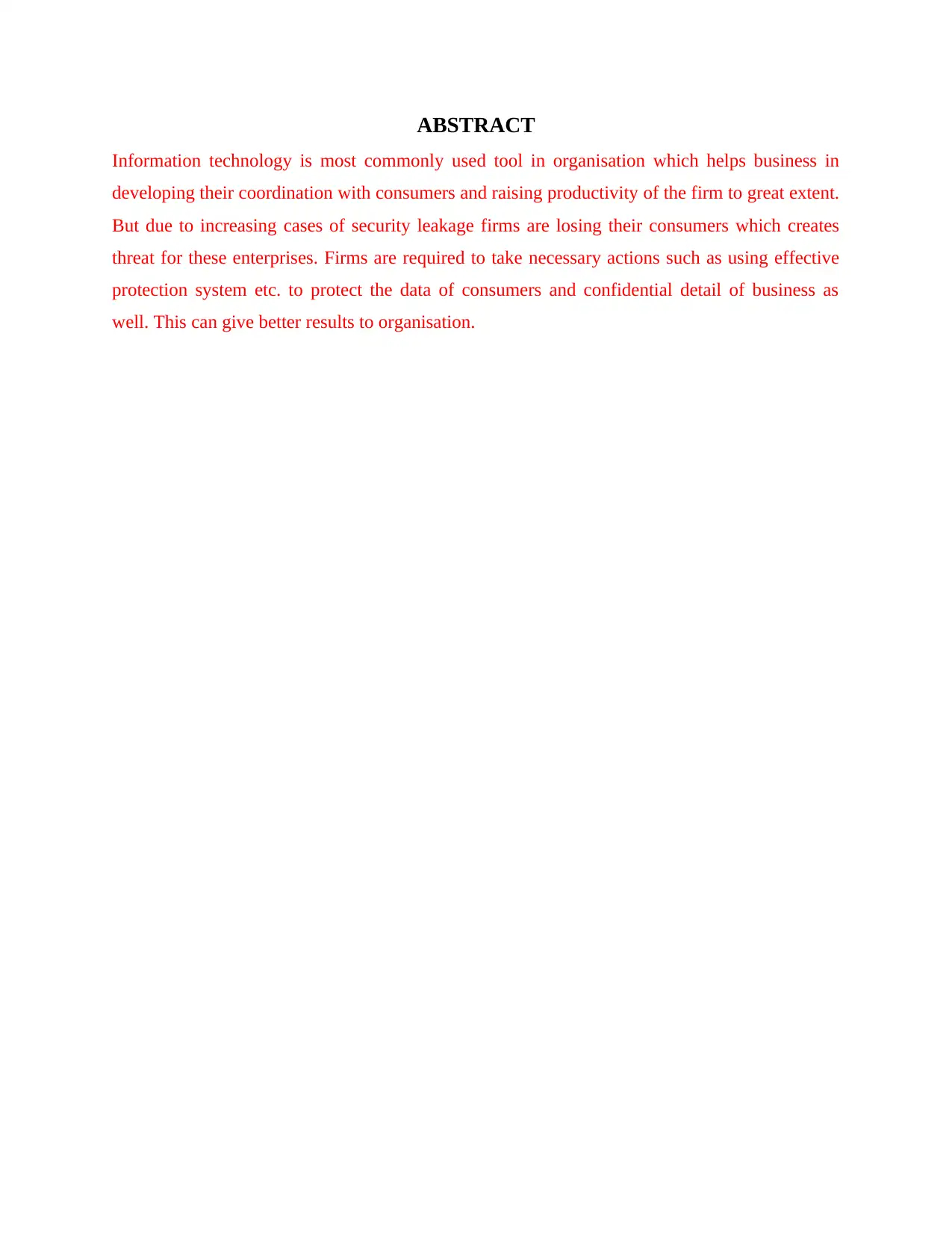
ABSTRACT
Information technology is most commonly used tool in organisation which helps business in
developing their coordination with consumers and raising productivity of the firm to great extent.
But due to increasing cases of security leakage firms are losing their consumers which creates
threat for these enterprises. Firms are required to take necessary actions such as using effective
protection system etc. to protect the data of consumers and confidential detail of business as
well. This can give better results to organisation.
Information technology is most commonly used tool in organisation which helps business in
developing their coordination with consumers and raising productivity of the firm to great extent.
But due to increasing cases of security leakage firms are losing their consumers which creates
threat for these enterprises. Firms are required to take necessary actions such as using effective
protection system etc. to protect the data of consumers and confidential detail of business as
well. This can give better results to organisation.
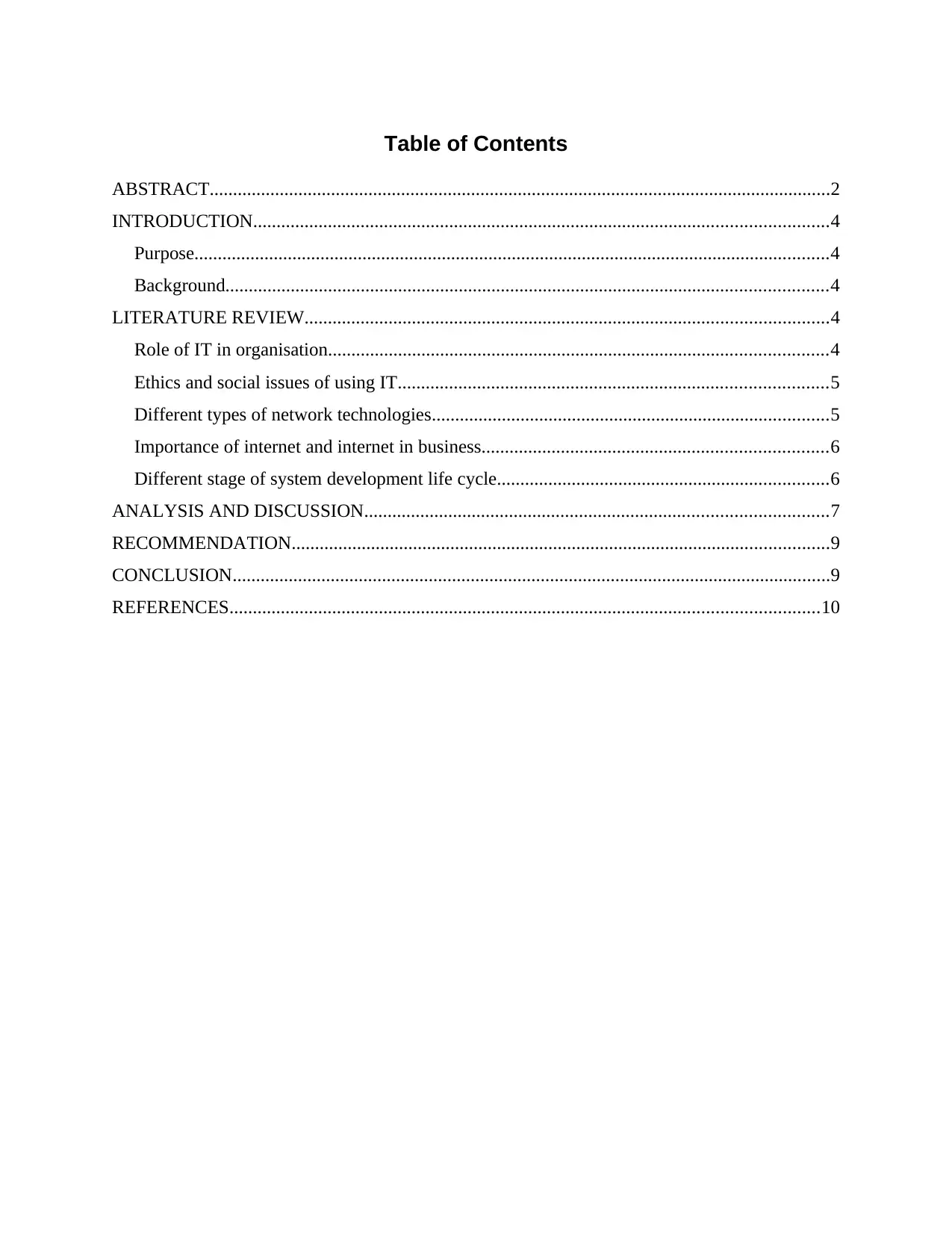
Table of Contents
ABSTRACT.....................................................................................................................................2
INTRODUCTION...........................................................................................................................4
Purpose........................................................................................................................................4
Background.................................................................................................................................4
LITERATURE REVIEW................................................................................................................4
Role of IT in organisation...........................................................................................................4
Ethics and social issues of using IT............................................................................................5
Different types of network technologies.....................................................................................5
Importance of internet and internet in business..........................................................................6
Different stage of system development life cycle.......................................................................6
ANALYSIS AND DISCUSSION...................................................................................................7
RECOMMENDATION...................................................................................................................9
CONCLUSION................................................................................................................................9
REFERENCES..............................................................................................................................10
ABSTRACT.....................................................................................................................................2
INTRODUCTION...........................................................................................................................4
Purpose........................................................................................................................................4
Background.................................................................................................................................4
LITERATURE REVIEW................................................................................................................4
Role of IT in organisation...........................................................................................................4
Ethics and social issues of using IT............................................................................................5
Different types of network technologies.....................................................................................5
Importance of internet and internet in business..........................................................................6
Different stage of system development life cycle.......................................................................6
ANALYSIS AND DISCUSSION...................................................................................................7
RECOMMENDATION...................................................................................................................9
CONCLUSION................................................................................................................................9
REFERENCES..............................................................................................................................10
⊘ This is a preview!⊘
Do you want full access?
Subscribe today to unlock all pages.

Trusted by 1+ million students worldwide
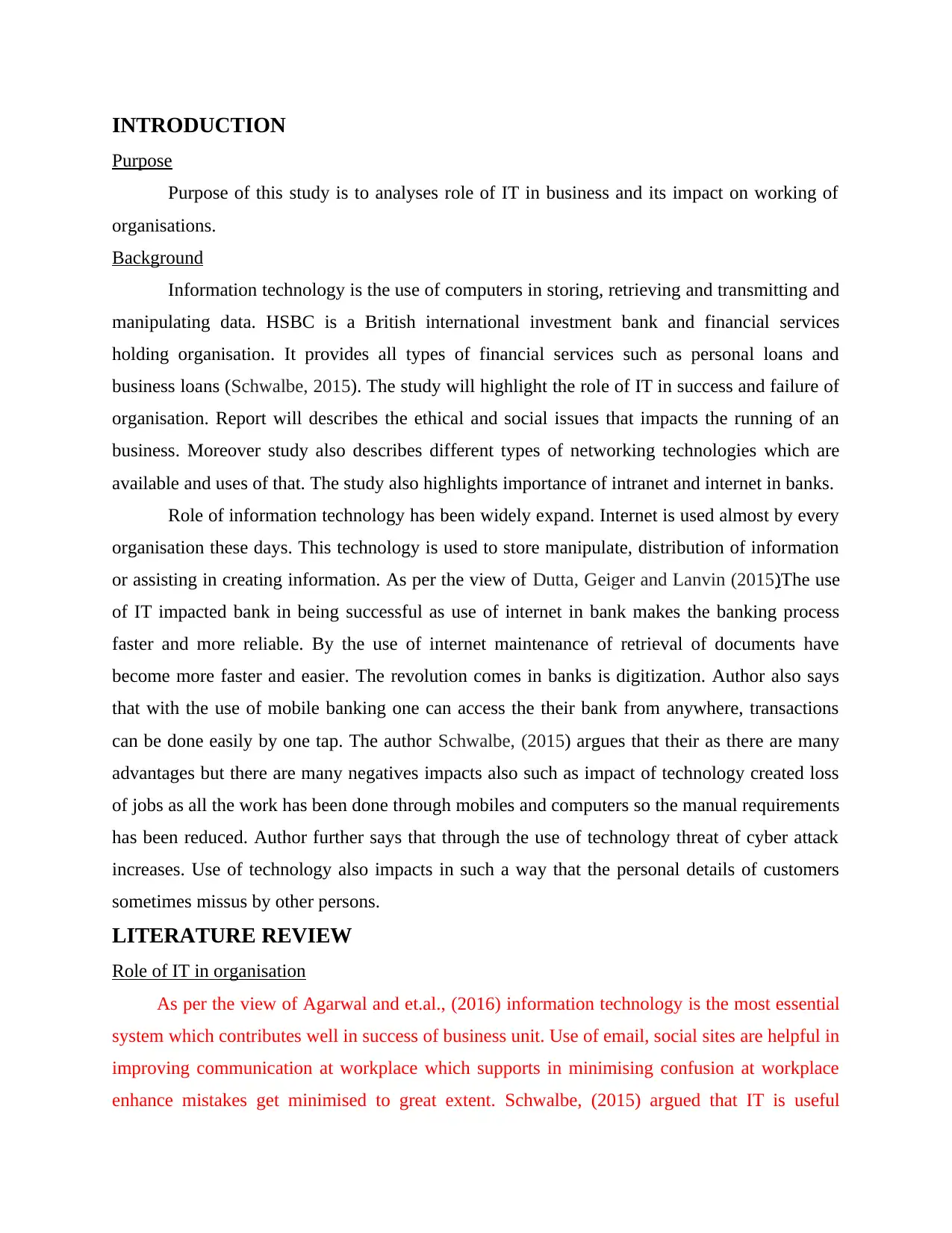
INTRODUCTION
Purpose
Purpose of this study is to analyses role of IT in business and its impact on working of
organisations.
Background
Information technology is the use of computers in storing, retrieving and transmitting and
manipulating data. HSBC is a British international investment bank and financial services
holding organisation. It provides all types of financial services such as personal loans and
business loans (Schwalbe, 2015). The study will highlight the role of IT in success and failure of
organisation. Report will describes the ethical and social issues that impacts the running of an
business. Moreover study also describes different types of networking technologies which are
available and uses of that. The study also highlights importance of intranet and internet in banks.
Role of information technology has been widely expand. Internet is used almost by every
organisation these days. This technology is used to store manipulate, distribution of information
or assisting in creating information. As per the view of Dutta, Geiger and Lanvin (2015)The use
of IT impacted bank in being successful as use of internet in bank makes the banking process
faster and more reliable. By the use of internet maintenance of retrieval of documents have
become more faster and easier. The revolution comes in banks is digitization. Author also says
that with the use of mobile banking one can access the their bank from anywhere, transactions
can be done easily by one tap. The author Schwalbe, (2015) argues that their as there are many
advantages but there are many negatives impacts also such as impact of technology created loss
of jobs as all the work has been done through mobiles and computers so the manual requirements
has been reduced. Author further says that through the use of technology threat of cyber attack
increases. Use of technology also impacts in such a way that the personal details of customers
sometimes missus by other persons.
LITERATURE REVIEW
Role of IT in organisation
As per the view of Agarwal and et.al., (2016) information technology is the most essential
system which contributes well in success of business unit. Use of email, social sites are helpful in
improving communication at workplace which supports in minimising confusion at workplace
enhance mistakes get minimised to great extent. Schwalbe, (2015) argued that IT is useful
Purpose
Purpose of this study is to analyses role of IT in business and its impact on working of
organisations.
Background
Information technology is the use of computers in storing, retrieving and transmitting and
manipulating data. HSBC is a British international investment bank and financial services
holding organisation. It provides all types of financial services such as personal loans and
business loans (Schwalbe, 2015). The study will highlight the role of IT in success and failure of
organisation. Report will describes the ethical and social issues that impacts the running of an
business. Moreover study also describes different types of networking technologies which are
available and uses of that. The study also highlights importance of intranet and internet in banks.
Role of information technology has been widely expand. Internet is used almost by every
organisation these days. This technology is used to store manipulate, distribution of information
or assisting in creating information. As per the view of Dutta, Geiger and Lanvin (2015)The use
of IT impacted bank in being successful as use of internet in bank makes the banking process
faster and more reliable. By the use of internet maintenance of retrieval of documents have
become more faster and easier. The revolution comes in banks is digitization. Author also says
that with the use of mobile banking one can access the their bank from anywhere, transactions
can be done easily by one tap. The author Schwalbe, (2015) argues that their as there are many
advantages but there are many negatives impacts also such as impact of technology created loss
of jobs as all the work has been done through mobiles and computers so the manual requirements
has been reduced. Author further says that through the use of technology threat of cyber attack
increases. Use of technology also impacts in such a way that the personal details of customers
sometimes missus by other persons.
LITERATURE REVIEW
Role of IT in organisation
As per the view of Agarwal and et.al., (2016) information technology is the most essential
system which contributes well in success of business unit. Use of email, social sites are helpful in
improving communication at workplace which supports in minimising confusion at workplace
enhance mistakes get minimised to great extent. Schwalbe, (2015) argued that IT is useful
Paraphrase This Document
Need a fresh take? Get an instant paraphrase of this document with our AI Paraphraser
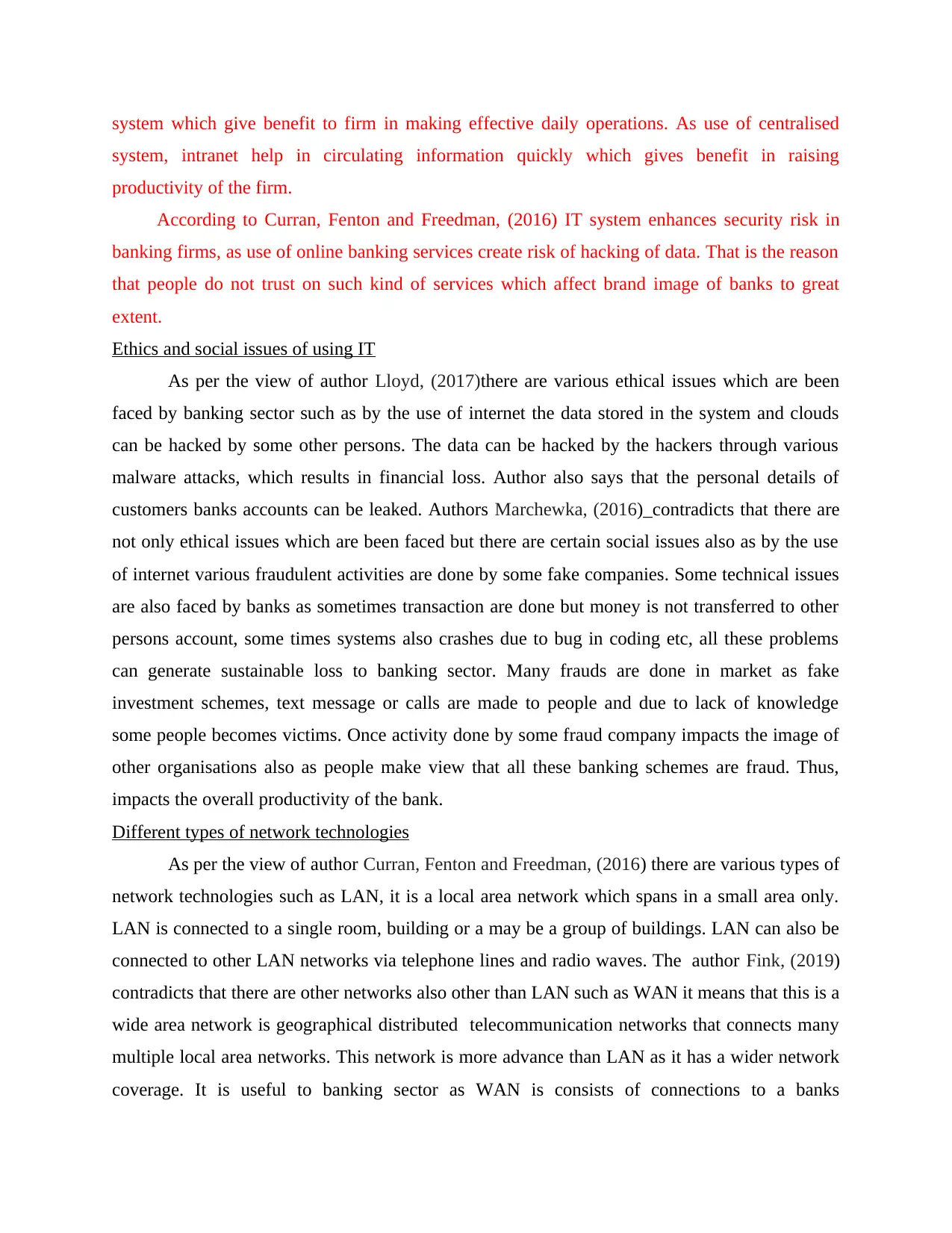
system which give benefit to firm in making effective daily operations. As use of centralised
system, intranet help in circulating information quickly which gives benefit in raising
productivity of the firm.
According to Curran, Fenton and Freedman, (2016) IT system enhances security risk in
banking firms, as use of online banking services create risk of hacking of data. That is the reason
that people do not trust on such kind of services which affect brand image of banks to great
extent.
Ethics and social issues of using IT
As per the view of author Lloyd, (2017)there are various ethical issues which are been
faced by banking sector such as by the use of internet the data stored in the system and clouds
can be hacked by some other persons. The data can be hacked by the hackers through various
malware attacks, which results in financial loss. Author also says that the personal details of
customers banks accounts can be leaked. Authors Marchewka, (2016)_contradicts that there are
not only ethical issues which are been faced but there are certain social issues also as by the use
of internet various fraudulent activities are done by some fake companies. Some technical issues
are also faced by banks as sometimes transaction are done but money is not transferred to other
persons account, some times systems also crashes due to bug in coding etc, all these problems
can generate sustainable loss to banking sector. Many frauds are done in market as fake
investment schemes, text message or calls are made to people and due to lack of knowledge
some people becomes victims. Once activity done by some fraud company impacts the image of
other organisations also as people make view that all these banking schemes are fraud. Thus,
impacts the overall productivity of the bank.
Different types of network technologies
As per the view of author Curran, Fenton and Freedman, (2016) there are various types of
network technologies such as LAN, it is a local area network which spans in a small area only.
LAN is connected to a single room, building or a may be a group of buildings. LAN can also be
connected to other LAN networks via telephone lines and radio waves. The author Fink, (2019)
contradicts that there are other networks also other than LAN such as WAN it means that this is a
wide area network is geographical distributed telecommunication networks that connects many
multiple local area networks. This network is more advance than LAN as it has a wider network
coverage. It is useful to banking sector as WAN is consists of connections to a banks
system, intranet help in circulating information quickly which gives benefit in raising
productivity of the firm.
According to Curran, Fenton and Freedman, (2016) IT system enhances security risk in
banking firms, as use of online banking services create risk of hacking of data. That is the reason
that people do not trust on such kind of services which affect brand image of banks to great
extent.
Ethics and social issues of using IT
As per the view of author Lloyd, (2017)there are various ethical issues which are been
faced by banking sector such as by the use of internet the data stored in the system and clouds
can be hacked by some other persons. The data can be hacked by the hackers through various
malware attacks, which results in financial loss. Author also says that the personal details of
customers banks accounts can be leaked. Authors Marchewka, (2016)_contradicts that there are
not only ethical issues which are been faced but there are certain social issues also as by the use
of internet various fraudulent activities are done by some fake companies. Some technical issues
are also faced by banks as sometimes transaction are done but money is not transferred to other
persons account, some times systems also crashes due to bug in coding etc, all these problems
can generate sustainable loss to banking sector. Many frauds are done in market as fake
investment schemes, text message or calls are made to people and due to lack of knowledge
some people becomes victims. Once activity done by some fraud company impacts the image of
other organisations also as people make view that all these banking schemes are fraud. Thus,
impacts the overall productivity of the bank.
Different types of network technologies
As per the view of author Curran, Fenton and Freedman, (2016) there are various types of
network technologies such as LAN, it is a local area network which spans in a small area only.
LAN is connected to a single room, building or a may be a group of buildings. LAN can also be
connected to other LAN networks via telephone lines and radio waves. The author Fink, (2019)
contradicts that there are other networks also other than LAN such as WAN it means that this is a
wide area network is geographical distributed telecommunication networks that connects many
multiple local area networks. This network is more advance than LAN as it has a wider network
coverage. It is useful to banking sector as WAN is consists of connections to a banks
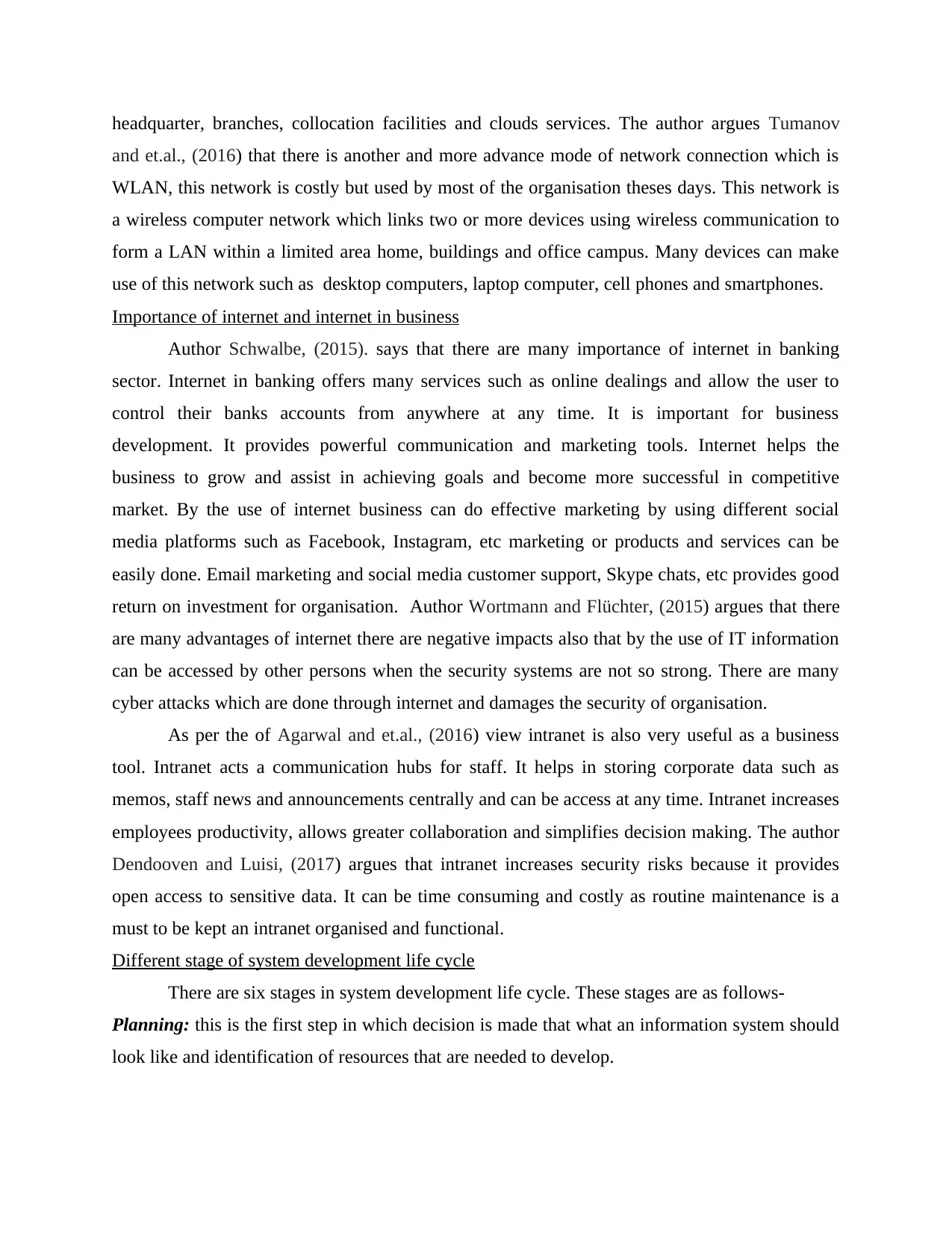
headquarter, branches, collocation facilities and clouds services. The author argues Tumanov
and et.al., (2016) that there is another and more advance mode of network connection which is
WLAN, this network is costly but used by most of the organisation theses days. This network is
a wireless computer network which links two or more devices using wireless communication to
form a LAN within a limited area home, buildings and office campus. Many devices can make
use of this network such as desktop computers, laptop computer, cell phones and smartphones.
Importance of internet and internet in business
Author Schwalbe, (2015). says that there are many importance of internet in banking
sector. Internet in banking offers many services such as online dealings and allow the user to
control their banks accounts from anywhere at any time. It is important for business
development. It provides powerful communication and marketing tools. Internet helps the
business to grow and assist in achieving goals and become more successful in competitive
market. By the use of internet business can do effective marketing by using different social
media platforms such as Facebook, Instagram, etc marketing or products and services can be
easily done. Email marketing and social media customer support, Skype chats, etc provides good
return on investment for organisation. Author Wortmann and Flüchter, (2015) argues that there
are many advantages of internet there are negative impacts also that by the use of IT information
can be accessed by other persons when the security systems are not so strong. There are many
cyber attacks which are done through internet and damages the security of organisation.
As per the of Agarwal and et.al., (2016) view intranet is also very useful as a business
tool. Intranet acts a communication hubs for staff. It helps in storing corporate data such as
memos, staff news and announcements centrally and can be access at any time. Intranet increases
employees productivity, allows greater collaboration and simplifies decision making. The author
Dendooven and Luisi, (2017) argues that intranet increases security risks because it provides
open access to sensitive data. It can be time consuming and costly as routine maintenance is a
must to be kept an intranet organised and functional.
Different stage of system development life cycle
There are six stages in system development life cycle. These stages are as follows-
Planning: this is the first step in which decision is made that what an information system should
look like and identification of resources that are needed to develop.
and et.al., (2016) that there is another and more advance mode of network connection which is
WLAN, this network is costly but used by most of the organisation theses days. This network is
a wireless computer network which links two or more devices using wireless communication to
form a LAN within a limited area home, buildings and office campus. Many devices can make
use of this network such as desktop computers, laptop computer, cell phones and smartphones.
Importance of internet and internet in business
Author Schwalbe, (2015). says that there are many importance of internet in banking
sector. Internet in banking offers many services such as online dealings and allow the user to
control their banks accounts from anywhere at any time. It is important for business
development. It provides powerful communication and marketing tools. Internet helps the
business to grow and assist in achieving goals and become more successful in competitive
market. By the use of internet business can do effective marketing by using different social
media platforms such as Facebook, Instagram, etc marketing or products and services can be
easily done. Email marketing and social media customer support, Skype chats, etc provides good
return on investment for organisation. Author Wortmann and Flüchter, (2015) argues that there
are many advantages of internet there are negative impacts also that by the use of IT information
can be accessed by other persons when the security systems are not so strong. There are many
cyber attacks which are done through internet and damages the security of organisation.
As per the of Agarwal and et.al., (2016) view intranet is also very useful as a business
tool. Intranet acts a communication hubs for staff. It helps in storing corporate data such as
memos, staff news and announcements centrally and can be access at any time. Intranet increases
employees productivity, allows greater collaboration and simplifies decision making. The author
Dendooven and Luisi, (2017) argues that intranet increases security risks because it provides
open access to sensitive data. It can be time consuming and costly as routine maintenance is a
must to be kept an intranet organised and functional.
Different stage of system development life cycle
There are six stages in system development life cycle. These stages are as follows-
Planning: this is the first step in which decision is made that what an information system should
look like and identification of resources that are needed to develop.
⊘ This is a preview!⊘
Do you want full access?
Subscribe today to unlock all pages.

Trusted by 1+ million students worldwide
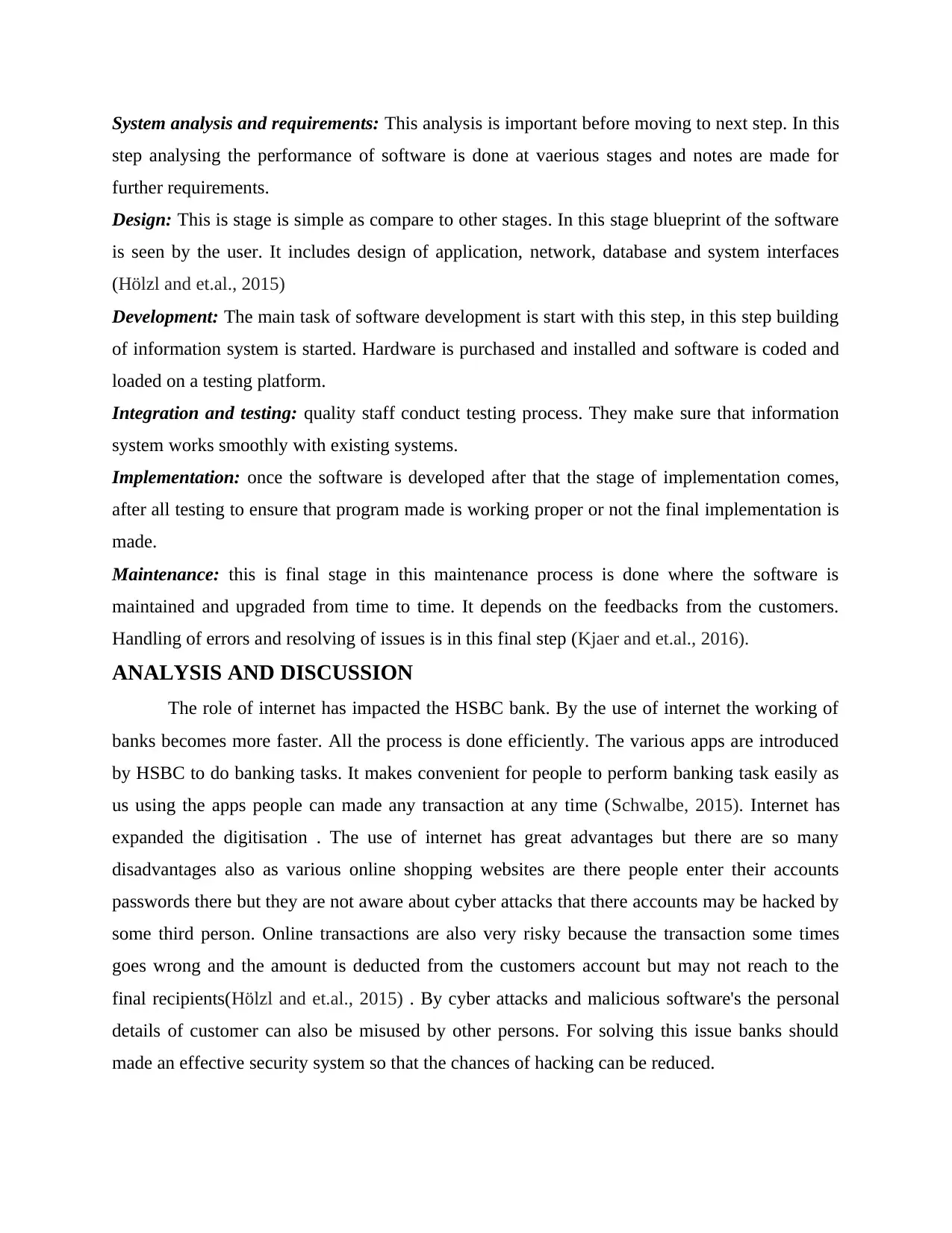
System analysis and requirements: This analysis is important before moving to next step. In this
step analysing the performance of software is done at vaerious stages and notes are made for
further requirements.
Design: This is stage is simple as compare to other stages. In this stage blueprint of the software
is seen by the user. It includes design of application, network, database and system interfaces
(Hölzl and et.al., 2015)
Development: The main task of software development is start with this step, in this step building
of information system is started. Hardware is purchased and installed and software is coded and
loaded on a testing platform.
Integration and testing: quality staff conduct testing process. They make sure that information
system works smoothly with existing systems.
Implementation: once the software is developed after that the stage of implementation comes,
after all testing to ensure that program made is working proper or not the final implementation is
made.
Maintenance: this is final stage in this maintenance process is done where the software is
maintained and upgraded from time to time. It depends on the feedbacks from the customers.
Handling of errors and resolving of issues is in this final step (Kjaer and et.al., 2016).
ANALYSIS AND DISCUSSION
The role of internet has impacted the HSBC bank. By the use of internet the working of
banks becomes more faster. All the process is done efficiently. The various apps are introduced
by HSBC to do banking tasks. It makes convenient for people to perform banking task easily as
us using the apps people can made any transaction at any time (Schwalbe, 2015). Internet has
expanded the digitisation . The use of internet has great advantages but there are so many
disadvantages also as various online shopping websites are there people enter their accounts
passwords there but they are not aware about cyber attacks that there accounts may be hacked by
some third person. Online transactions are also very risky because the transaction some times
goes wrong and the amount is deducted from the customers account but may not reach to the
final recipients(Hölzl and et.al., 2015) . By cyber attacks and malicious software's the personal
details of customer can also be misused by other persons. For solving this issue banks should
made an effective security system so that the chances of hacking can be reduced.
step analysing the performance of software is done at vaerious stages and notes are made for
further requirements.
Design: This is stage is simple as compare to other stages. In this stage blueprint of the software
is seen by the user. It includes design of application, network, database and system interfaces
(Hölzl and et.al., 2015)
Development: The main task of software development is start with this step, in this step building
of information system is started. Hardware is purchased and installed and software is coded and
loaded on a testing platform.
Integration and testing: quality staff conduct testing process. They make sure that information
system works smoothly with existing systems.
Implementation: once the software is developed after that the stage of implementation comes,
after all testing to ensure that program made is working proper or not the final implementation is
made.
Maintenance: this is final stage in this maintenance process is done where the software is
maintained and upgraded from time to time. It depends on the feedbacks from the customers.
Handling of errors and resolving of issues is in this final step (Kjaer and et.al., 2016).
ANALYSIS AND DISCUSSION
The role of internet has impacted the HSBC bank. By the use of internet the working of
banks becomes more faster. All the process is done efficiently. The various apps are introduced
by HSBC to do banking tasks. It makes convenient for people to perform banking task easily as
us using the apps people can made any transaction at any time (Schwalbe, 2015). Internet has
expanded the digitisation . The use of internet has great advantages but there are so many
disadvantages also as various online shopping websites are there people enter their accounts
passwords there but they are not aware about cyber attacks that there accounts may be hacked by
some third person. Online transactions are also very risky because the transaction some times
goes wrong and the amount is deducted from the customers account but may not reach to the
final recipients(Hölzl and et.al., 2015) . By cyber attacks and malicious software's the personal
details of customer can also be misused by other persons. For solving this issue banks should
made an effective security system so that the chances of hacking can be reduced.
Paraphrase This Document
Need a fresh take? Get an instant paraphrase of this document with our AI Paraphraser
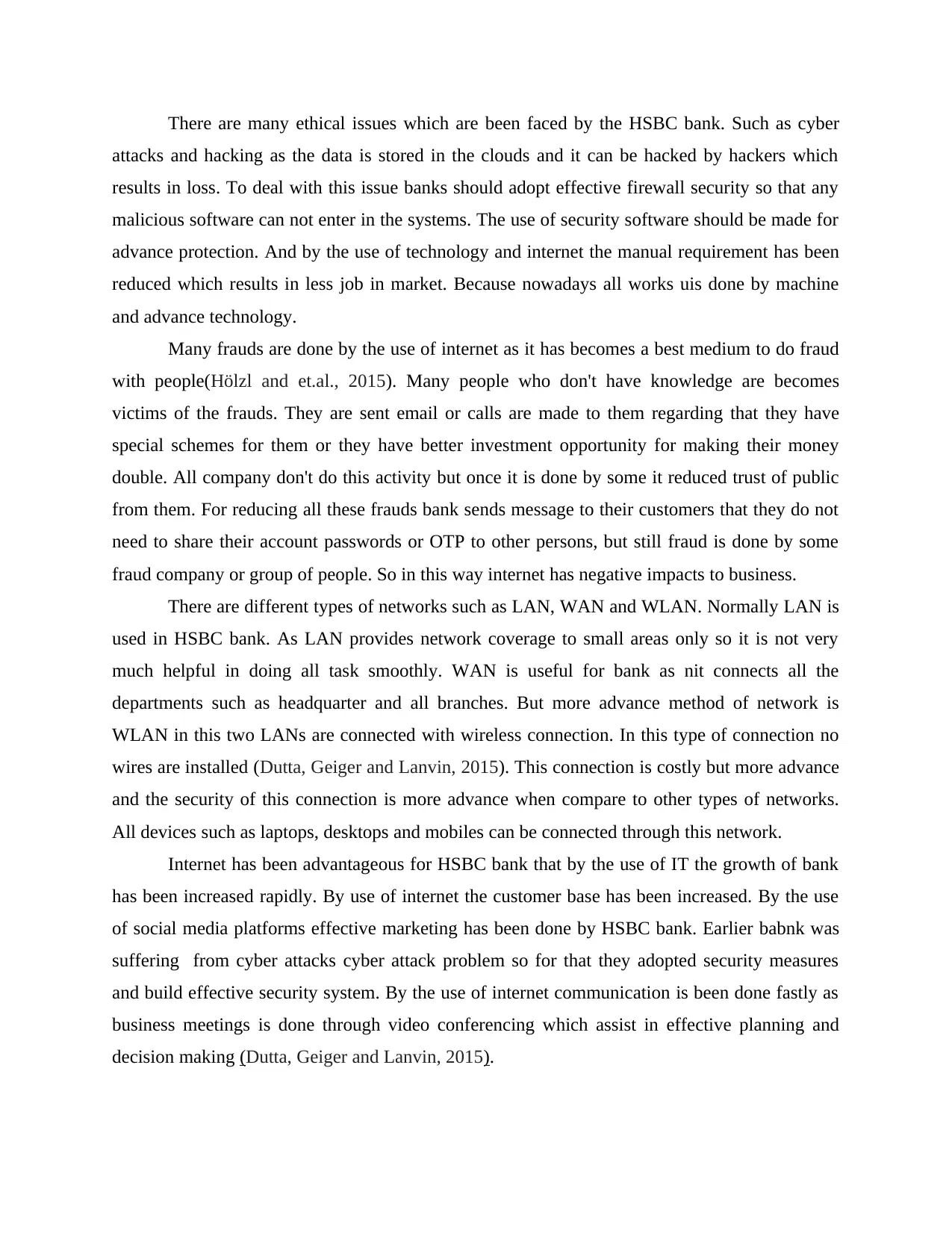
There are many ethical issues which are been faced by the HSBC bank. Such as cyber
attacks and hacking as the data is stored in the clouds and it can be hacked by hackers which
results in loss. To deal with this issue banks should adopt effective firewall security so that any
malicious software can not enter in the systems. The use of security software should be made for
advance protection. And by the use of technology and internet the manual requirement has been
reduced which results in less job in market. Because nowadays all works uis done by machine
and advance technology.
Many frauds are done by the use of internet as it has becomes a best medium to do fraud
with people(Hölzl and et.al., 2015). Many people who don't have knowledge are becomes
victims of the frauds. They are sent email or calls are made to them regarding that they have
special schemes for them or they have better investment opportunity for making their money
double. All company don't do this activity but once it is done by some it reduced trust of public
from them. For reducing all these frauds bank sends message to their customers that they do not
need to share their account passwords or OTP to other persons, but still fraud is done by some
fraud company or group of people. So in this way internet has negative impacts to business.
There are different types of networks such as LAN, WAN and WLAN. Normally LAN is
used in HSBC bank. As LAN provides network coverage to small areas only so it is not very
much helpful in doing all task smoothly. WAN is useful for bank as nit connects all the
departments such as headquarter and all branches. But more advance method of network is
WLAN in this two LANs are connected with wireless connection. In this type of connection no
wires are installed (Dutta, Geiger and Lanvin, 2015). This connection is costly but more advance
and the security of this connection is more advance when compare to other types of networks.
All devices such as laptops, desktops and mobiles can be connected through this network.
Internet has been advantageous for HSBC bank that by the use of IT the growth of bank
has been increased rapidly. By use of internet the customer base has been increased. By the use
of social media platforms effective marketing has been done by HSBC bank. Earlier babnk was
suffering from cyber attacks cyber attack problem so for that they adopted security measures
and build effective security system. By the use of internet communication is been done fastly as
business meetings is done through video conferencing which assist in effective planning and
decision making (Dutta, Geiger and Lanvin, 2015).
attacks and hacking as the data is stored in the clouds and it can be hacked by hackers which
results in loss. To deal with this issue banks should adopt effective firewall security so that any
malicious software can not enter in the systems. The use of security software should be made for
advance protection. And by the use of technology and internet the manual requirement has been
reduced which results in less job in market. Because nowadays all works uis done by machine
and advance technology.
Many frauds are done by the use of internet as it has becomes a best medium to do fraud
with people(Hölzl and et.al., 2015). Many people who don't have knowledge are becomes
victims of the frauds. They are sent email or calls are made to them regarding that they have
special schemes for them or they have better investment opportunity for making their money
double. All company don't do this activity but once it is done by some it reduced trust of public
from them. For reducing all these frauds bank sends message to their customers that they do not
need to share their account passwords or OTP to other persons, but still fraud is done by some
fraud company or group of people. So in this way internet has negative impacts to business.
There are different types of networks such as LAN, WAN and WLAN. Normally LAN is
used in HSBC bank. As LAN provides network coverage to small areas only so it is not very
much helpful in doing all task smoothly. WAN is useful for bank as nit connects all the
departments such as headquarter and all branches. But more advance method of network is
WLAN in this two LANs are connected with wireless connection. In this type of connection no
wires are installed (Dutta, Geiger and Lanvin, 2015). This connection is costly but more advance
and the security of this connection is more advance when compare to other types of networks.
All devices such as laptops, desktops and mobiles can be connected through this network.
Internet has been advantageous for HSBC bank that by the use of IT the growth of bank
has been increased rapidly. By use of internet the customer base has been increased. By the use
of social media platforms effective marketing has been done by HSBC bank. Earlier babnk was
suffering from cyber attacks cyber attack problem so for that they adopted security measures
and build effective security system. By the use of internet communication is been done fastly as
business meetings is done through video conferencing which assist in effective planning and
decision making (Dutta, Geiger and Lanvin, 2015).
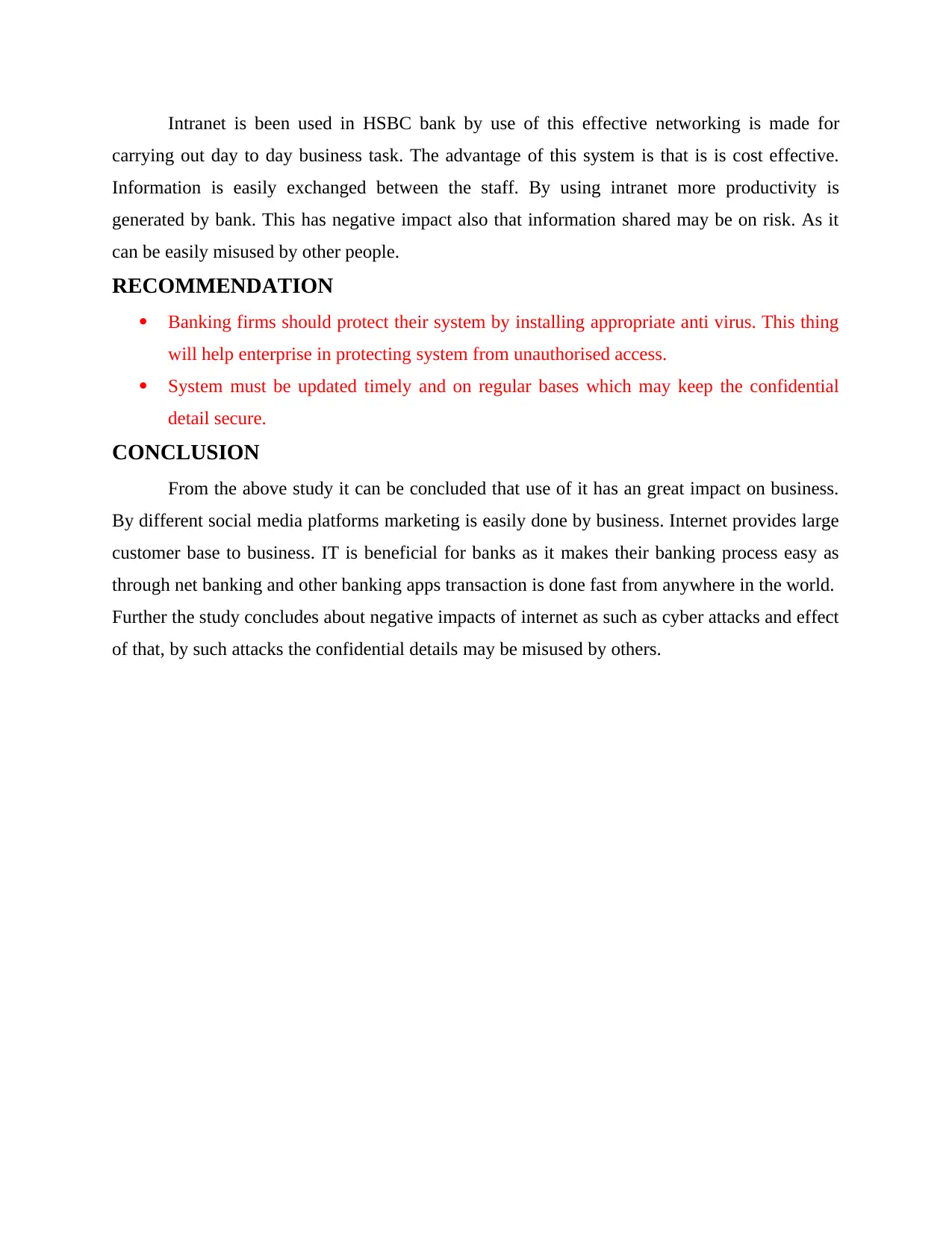
Intranet is been used in HSBC bank by use of this effective networking is made for
carrying out day to day business task. The advantage of this system is that is is cost effective.
Information is easily exchanged between the staff. By using intranet more productivity is
generated by bank. This has negative impact also that information shared may be on risk. As it
can be easily misused by other people.
RECOMMENDATION
Banking firms should protect their system by installing appropriate anti virus. This thing
will help enterprise in protecting system from unauthorised access.
System must be updated timely and on regular bases which may keep the confidential
detail secure.
CONCLUSION
From the above study it can be concluded that use of it has an great impact on business.
By different social media platforms marketing is easily done by business. Internet provides large
customer base to business. IT is beneficial for banks as it makes their banking process easy as
through net banking and other banking apps transaction is done fast from anywhere in the world.
Further the study concludes about negative impacts of internet as such as cyber attacks and effect
of that, by such attacks the confidential details may be misused by others.
carrying out day to day business task. The advantage of this system is that is is cost effective.
Information is easily exchanged between the staff. By using intranet more productivity is
generated by bank. This has negative impact also that information shared may be on risk. As it
can be easily misused by other people.
RECOMMENDATION
Banking firms should protect their system by installing appropriate anti virus. This thing
will help enterprise in protecting system from unauthorised access.
System must be updated timely and on regular bases which may keep the confidential
detail secure.
CONCLUSION
From the above study it can be concluded that use of it has an great impact on business.
By different social media platforms marketing is easily done by business. Internet provides large
customer base to business. IT is beneficial for banks as it makes their banking process easy as
through net banking and other banking apps transaction is done fast from anywhere in the world.
Further the study concludes about negative impacts of internet as such as cyber attacks and effect
of that, by such attacks the confidential details may be misused by others.
⊘ This is a preview!⊘
Do you want full access?
Subscribe today to unlock all pages.

Trusted by 1+ million students worldwide
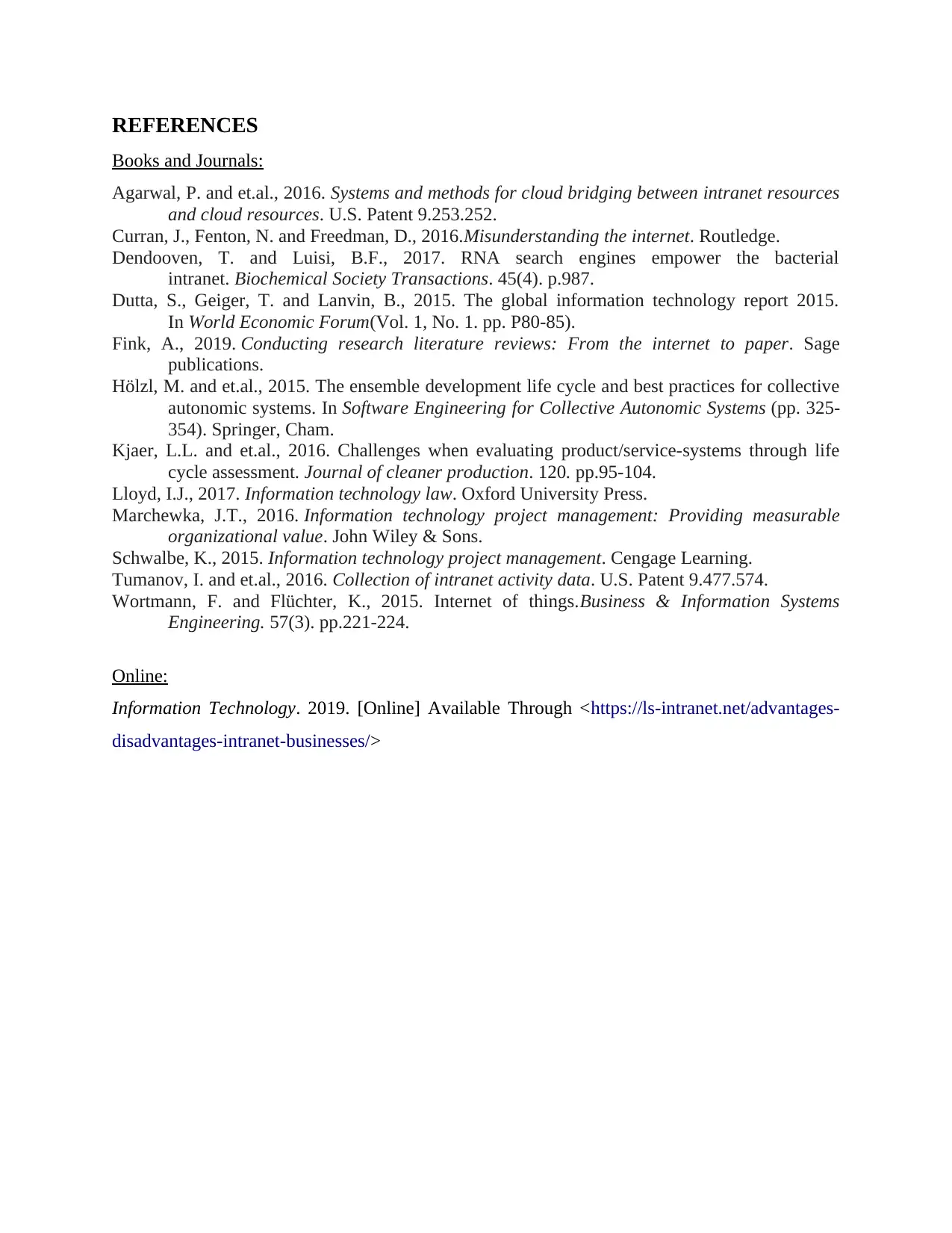
REFERENCES
Books and Journals:
Agarwal, P. and et.al., 2016. Systems and methods for cloud bridging between intranet resources
and cloud resources. U.S. Patent 9.253.252.
Curran, J., Fenton, N. and Freedman, D., 2016.Misunderstanding the internet. Routledge.
Dendooven, T. and Luisi, B.F., 2017. RNA search engines empower the bacterial
intranet. Biochemical Society Transactions. 45(4). p.987.
Dutta, S., Geiger, T. and Lanvin, B., 2015. The global information technology report 2015.
In World Economic Forum(Vol. 1, No. 1. pp. P80-85).
Fink, A., 2019. Conducting research literature reviews: From the internet to paper. Sage
publications.
Hölzl, M. and et.al., 2015. The ensemble development life cycle and best practices for collective
autonomic systems. In Software Engineering for Collective Autonomic Systems (pp. 325-
354). Springer, Cham.
Kjaer, L.L. and et.al., 2016. Challenges when evaluating product/service-systems through life
cycle assessment. Journal of cleaner production. 120. pp.95-104.
Lloyd, I.J., 2017. Information technology law. Oxford University Press.
Marchewka, J.T., 2016. Information technology project management: Providing measurable
organizational value. John Wiley & Sons.
Schwalbe, K., 2015. Information technology project management. Cengage Learning.
Tumanov, I. and et.al., 2016. Collection of intranet activity data. U.S. Patent 9.477.574.
Wortmann, F. and Flüchter, K., 2015. Internet of things.Business & Information Systems
Engineering. 57(3). pp.221-224.
Online:
Information Technology. 2019. [Online] Available Through <https://ls-intranet.net/advantages-
disadvantages-intranet-businesses/>
Books and Journals:
Agarwal, P. and et.al., 2016. Systems and methods for cloud bridging between intranet resources
and cloud resources. U.S. Patent 9.253.252.
Curran, J., Fenton, N. and Freedman, D., 2016.Misunderstanding the internet. Routledge.
Dendooven, T. and Luisi, B.F., 2017. RNA search engines empower the bacterial
intranet. Biochemical Society Transactions. 45(4). p.987.
Dutta, S., Geiger, T. and Lanvin, B., 2015. The global information technology report 2015.
In World Economic Forum(Vol. 1, No. 1. pp. P80-85).
Fink, A., 2019. Conducting research literature reviews: From the internet to paper. Sage
publications.
Hölzl, M. and et.al., 2015. The ensemble development life cycle and best practices for collective
autonomic systems. In Software Engineering for Collective Autonomic Systems (pp. 325-
354). Springer, Cham.
Kjaer, L.L. and et.al., 2016. Challenges when evaluating product/service-systems through life
cycle assessment. Journal of cleaner production. 120. pp.95-104.
Lloyd, I.J., 2017. Information technology law. Oxford University Press.
Marchewka, J.T., 2016. Information technology project management: Providing measurable
organizational value. John Wiley & Sons.
Schwalbe, K., 2015. Information technology project management. Cengage Learning.
Tumanov, I. and et.al., 2016. Collection of intranet activity data. U.S. Patent 9.477.574.
Wortmann, F. and Flüchter, K., 2015. Internet of things.Business & Information Systems
Engineering. 57(3). pp.221-224.
Online:
Information Technology. 2019. [Online] Available Through <https://ls-intranet.net/advantages-
disadvantages-intranet-businesses/>
1 out of 10
Related Documents
Your All-in-One AI-Powered Toolkit for Academic Success.
+13062052269
info@desklib.com
Available 24*7 on WhatsApp / Email
![[object Object]](/_next/static/media/star-bottom.7253800d.svg)
Unlock your academic potential
Copyright © 2020–2025 A2Z Services. All Rights Reserved. Developed and managed by ZUCOL.





